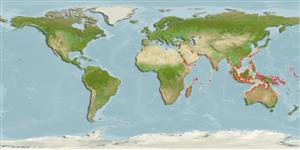Common names from other countries
Environment: milieu / climate zone / depth range / distribution range
Ecologie
marien demersaal; diepte 20 - 27 m (Ref. 11790). Tropical
Indo-West Pacific: Persian Gulf east to India; throughout the Malay Peninsula to the Philippines and Indonesia.
Grootte / Gewicht / Leeftijd
Maturity: Lm ? range ? - ? cm
Max length : 35.0 cm SL mannelijk / geslacht onbekend; (Ref. 9774); common length : 20.0 cm SL mannelijk / geslacht onbekend; (Ref. 9774)
Dorsale stekels (totaal) : 0; Dorsale zachte stralen (totaal) : 72 - 74; Anale stekels: 0; Anale zachte stralen: 58 - 59. Body brownish, a small dark blotch at junction of straight and curved parts of lateral line. Body deep ovoid, its depth 1.8 to 2 times in SL. Head length 3.1 to 3.3 times in SL. Upper-eye diameter 5.3 to 5.9 times in head length. Maxilla extending to below posterior margin of lower eye. Upper-jaw length 2.3 to 2.4 times in head length. Teeth in upper jaw small and close-set laterally, and enlarged anteriorly. Teeth in lower jaw stronger and more widely spaced than those of upper jaw. Pectoral fin on ocular side with 12-13 soft rays (Ref 9774).
Found on the muddy and sandy trawling grounds of the continental shelf. Feeds on benthic organisms. Sold mostly fresh in markets.
Levenscyclus en paargedrag
Maturities | Voortplanting | Spawnings | Egg(s) | Fecundities | Larven
Distinct pairing (Ref. 205).
Nielsen, J.G., 1984. Bothidae. In W. Fischer and G. Bianchi (eds.) FAO species identification sheets for fishery purposes. Western Indian Ocean fishing area 51. Vol. 1. FAO, Rome. pag. var. (Ref. 3322)
Status op de Rode Lijst van het IUCN (Ref. 130435)
CITES (Ref. 128078)
Not Evaluated
Gevaar voor de mens
Harmless
Gebruik door de mens
Visserij: commercieel
Tools
Speciale rapporten
Download XML
Internetbronnen
Estimates based on models
Preferred temperature (Ref.
115969): 24.5 - 29.1, mean 28 (based on 98 cells).
Fylogenetische diversiteitsindex (Ref.
82804): PD
50 = 0.5000 [Uniqueness, from 0.5 = low to 2.0 = high].
Bayesian length-weight: a=0.00741 (0.00343 - 0.01604), b=3.17 (3.00 - 3.34), in cm Total Length, based on LWR estimates for this Genus-body shape (Ref.
93245).
Trofisch niveau (Ref.
69278): 3.4 ±0.42 se; based on food items.
Weerstandsvermogen (Ref.
120179): Gemiddeld, minimale populatieverdubbelingstijd 1,4-4,4 jaar (Preliminary K or Fecundity.).
Fishing Vulnerability (Ref.
59153): Low to moderate vulnerability (33 of 100).
